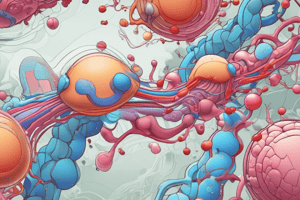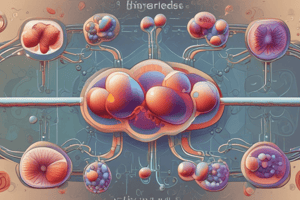Podcast
Questions and Answers
What products are formed when a triacylglycerol is hydrolyzed in the presence of an acid, base, or enzyme?
What products are formed when a triacylglycerol is hydrolyzed in the presence of an acid, base, or enzyme?
- One glycerol molecule and three fatty acid molecules (correct)
- Three glycerol molecules and three fatty acid molecules
- Three glycerol molecules and one fatty acid molecule
- One glycerol molecule and one fatty acid molecule
Which of the following best describes the role of adipose tissue in the human body?
Which of the following best describes the role of adipose tissue in the human body?
- Primary site for protein synthesis.
- Breaksdown carbohydrates to release glucose.
- Insulation and long-term energy storage. (correct)
- Short-term energy storage for quick bursts of activity.
What is the main difference between energy storage in carbohydrates versus triacylglycerols?
What is the main difference between energy storage in carbohydrates versus triacylglycerols?
- Carbohydrates provide long-term energy, while triacylglycerols provide short-term energy.
- Both carbohydrates and triacylglycerols provide equal amounts of long-term energy.
- Both carbohydrates and triacylglycerols provide equal amounts of short-term energy.
- Triacylglycerols provide long-term energy, while carbohydrates provide short-term energy. (correct)
What is the process by which soaps are produced?
What is the process by which soaps are produced?
A soap molecule is described as having two parts, what are they?
A soap molecule is described as having two parts, what are they?
How do soaps remove dirt and grease?
How do soaps remove dirt and grease?
What are the two main classes of phospholipids?
What are the two main classes of phospholipids?
Phospholipids are considered organic derivatives of what?
Phospholipids are considered organic derivatives of what?
Compared to triacylglycerols, what is a key difference in the structure of phosphoacylglycerols?
Compared to triacylglycerols, what is a key difference in the structure of phosphoacylglycerols?
What is the functional group called when two of the H atoms of phosphoric acid are replaced by R groups in phospholipids?
What is the functional group called when two of the H atoms of phosphoric acid are replaced by R groups in phospholipids?
What structural feature do sphingomyelins and phosphoacylglycerols have in common?
What structural feature do sphingomyelins and phosphoacylglycerols have in common?
What is the role of the myelin sheath, which is rich in sphingomyelins, in nerve cells?
What is the role of the myelin sheath, which is rich in sphingomyelins, in nerve cells?
What distinguishes sphingomyelins from triacylglycerols and phosphoacylglycerols?
What distinguishes sphingomyelins from triacylglycerols and phosphoacylglycerols?
Which of the following is true regarding the types of bonds found in sphingomyelins?
Which of the following is true regarding the types of bonds found in sphingomyelins?
Where are phosphoacylglycerols and sphingomyelins primarily found?
Where are phosphoacylglycerols and sphingomyelins primarily found?
Flashcards
Hydrolysis of Triacylglycerols
Hydrolysis of Triacylglycerols
The reaction where triacylglycerols react with water to produce glycerol and three fatty acids, usually with the help of an acid, base, or enzyme.
Adipose Cells
Adipose Cells
Cells in which humans store triacylglycerols, found beneath the skin, in bone marrow, and around organs.
Adipose Tissue
Adipose Tissue
Tissue primarily composed of fat-storing cells, providing insulation and long-term energy storage in the body.
Lipases
Lipases
Signup and view all the flashcards
Soaps according to the text
Soaps according to the text
Signup and view all the flashcards
Saponification Definition
Saponification Definition
Signup and view all the flashcards
Micelles Definition
Micelles Definition
Signup and view all the flashcards
Polar Head (in soap)
Polar Head (in soap)
Signup and view all the flashcards
Nonpolar Tail (in soap)
Nonpolar Tail (in soap)
Signup and view all the flashcards
Phospholipids Definition
Phospholipids Definition
Signup and view all the flashcards
Phosphoacylglycerols and Sphingomyelins
Phosphoacylglycerols and Sphingomyelins
Signup and view all the flashcards
Phosphoacylglycerols
Phosphoacylglycerols
Signup and view all the flashcards
Cephalin/phosphatidylethanolamine definition
Cephalin/phosphatidylethanolamine definition
Signup and view all the flashcards
Lecithin/phosphatidylcholine
Lecithin/phosphatidylcholine
Signup and view all the flashcards
Myelin Sheath
Myelin Sheath
Signup and view all the flashcards
Study Notes
- Triacylglycerols are hydrolyzed with water with acid, base, or enzymes to form glycerol and three fatty acids.
- Hydrolysis of tristearin with aqueous sulfuric acid results in glycerol and three stearic acid molecules.
- Hydrolysis breaks the three bonds between carbonyl carbons and ester oxygen atoms.
- Since tristearin has three identical R groups on the carbonyl carbons, hydrolysis yields three molecules of identical fatty acids (stearic acid).
- Triacylglycerols containing different R groups yield mixtures of fatty acids upon hydrolysis.
Products of TAG Hydrolysis
- To determine the products of ester hydrolysis, cleave the three C—O bonds at the carbonyl carbons to form glycerol and three fatty acids (RCOOH).
- Hydrolysis forms glycerol, stearic, palmitic, and palmitoleic acids.
Metabolism of Triacylglycerols
- Humans store energy as triacylglycerols in adipose cells, beneath the skin, in bone marrow, in the breasts (women), around the kidneys, and in the pelvis.
- Adipose tissue contains many adipose cells, full of lipid molecules where cytoplasm and nucleus take up a small amount of space.
- The number of adipose cells remains constant in adulthood.
- Weight loss or gain changes the stored lipid amount per cell, but not the number of adipose cells.
- Adipose tissue insulates the organism and provides energy for long-term metabolic needs.
- The first step in triacylglycerol metabolism is the hydrolysis of ester bonds to form glycerol and three fatty acids, known as ester hydrolysis.
- Lipases catalyze this reaction in cells.
- Triacylglycerol metabolism yields carbon dioxide, water, and a lot of energy.
- Triacylglycerols store 9 kcal/g, while carbohydrates and proteins store only 4 kcal/g.
Soap Synthesis
- Soaps are salts of carboxylic acids, containing many carbons in a hydrocarbon chain.
- They are salts of fatty acids.
- Sodium stearate is a sodium salt of stearic acid, an 18-carbon saturated fatty acid.
- Soaps are made by the basic hydrolysis (saponification) of a triacylglycerol.
- Heating animal fat or vegetable oil with aqueous base hydrolyzes the three esters to form glycerol and sodium salts of three fatty acids.
How Does Soap Clean Away Dirt?
- Soap molecules have a polar head (ionic end) and a nonpolar tail (carbon chain).
- Dissolving soap in water forms spherical micelles with ionic heads on the surface and nonpolar tails packed together.
- Ionic heads interact with the polar solvent water and bring the nonpolar hydrocarbon portion of the soap into solution.
- The polar solvent water alone cannot dissolve nonpolar hydrocarbons.
- When mixed with water, the nonpolar tails dissolve the dirt in the micelle's interior.
- Polar heads remain on the surface to interact with water.
- Micelles help to remove nonpolar hydrocarbons from skin and clothes by dissolving it in the polar solvent water.
Phospholipids
- Phospholipids contain a phosphorus atom, found almost exclusively in the cell membranes of plants and animals.
- Two common types of phospholipids: phosphoacylglycerols and sphingomyelins.
- Phospholipids are organic derivatives of phosphoric acid (H3PO4), with two H atoms replaced by R groups.
- This functional group is called a phosphodiester; the remaining –OH group on phosphorus loses its proton, giving the phosphodiester a negative charge.
Phosphoacylglycerols
-
Phosphoacylglycerols (phosphoglycerides) are the second most abundant lipid type that form the principal lipid component of most membranes.
-
Their structure resembles triacylglycerols, but only two glycerol hydroxyl groups are esterified with fatty acids.
-
The third OH group is part of a phosphodiester, bonded to an alkyl group (R") from a low molecular weight alcohol.
-
Two prominent types exist that differ in the R" group in the phosphodiester
-
Cephalin or phosphatidylethanolamine: R" = CH2CH2NH3+
-
Lecithin or phosphatidylcholine: R" = CH2CH2N(CH3)3+
-
The phosphorus side chain differentiates a phosphoacylglycerol from a triacylglycerol.
-
Two fatty acid side chains form nonpolar "tails" that lie parallel to each other.
-
The phosphodiester end of the molecule is a polar “head.”
Sphingomyelins
- Sphingomyelins are the second major class of phospholipids, differing from triacylglycerols and phosphoacylglycerols in two ways:
- They do not contain a glycerol backbone, derived from sphingosine instead.
- They do not contain an ester, their single fatty acid is bonded to the carbon backbone by an amide bond.
- Like phosphoacylglycerols, sphingomyelins contain a phosphodiester derived from ethanolamine or choline, resulting in a polar (ionic) head and two nonpolar tails.
- The myelin sheath, which surrounds and insulates nerve cells, is rich in sphingomyelins and vital for proper nerve function.
Studying That Suits You
Use AI to generate personalized quizzes and flashcards to suit your learning preferences.
Related Documents
Description
Triacylglycerols are hydrolyzed with water, acid, base, or enzymes to form glycerol and fatty acids, breaking bonds between carbonyl carbons and ester oxygen atoms. Hydrolysis of triacylglycerols yields glycerol and mixtures of different fatty acids. Humans store energy as triacylglycerols in adipose cells.




